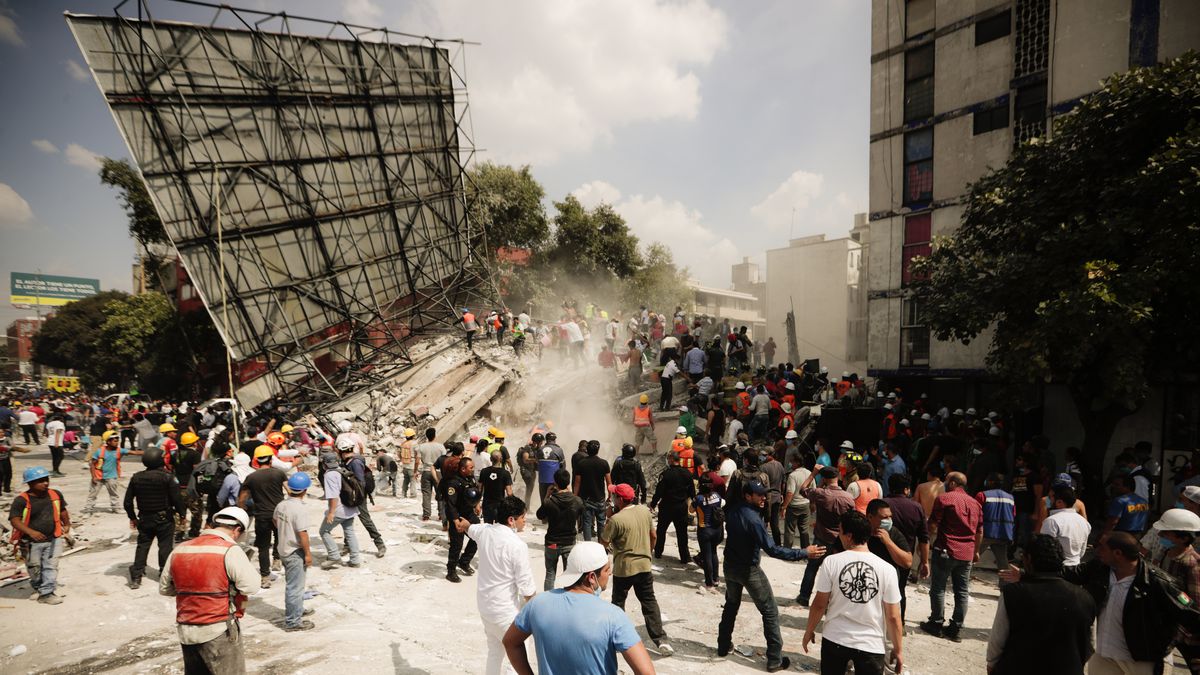By Ross Stein (Temblor), Professor Shinji Toda (IRIDeS, Tohoku University, Japan), Geoff Ely (Temblor), and David Jacobson (Temblor)
¿Están relacionados los dos terremotos principales de México? y ¿qué podría suceder después?

A burning question in all our minds is whether the M=8.1 Chiapas earthquake in any sense triggered the M=7.1 shock twelve days later and 600 km (360 mi) away. Their tantalizing connection is not just time and distance, but also their similar depth and mechanism: They did not slip the megathrust surface of the subduction zones, but instead fractured the oceanic slab of the Cocos tectonic plate as it descends beneath the North American plate. In all likelihood, both events were a consequence of the downward bending of the oceanic slab, which subjects it to concentrated tension at the bend.
Did the M=8.1 permanently stress the site of the M=7.1?
The answer is a qualified ‘no.’ We calculated the stress imparted by the M=8.1 shock to the fault that ruptured in the M=7.1 (using our Coulomb 3.4 software) at its nucleation point or ‘hypocenter’, and find a tiny push that would favor rupture. But ‘tiny,’ not ‘push,’ is the operative word here: The stress increase is less than the fault would experience from the twice-daily tides, and so it should be inconsequential. Its smaller than rubbing your fingers together. So, we would be very comfortable in saying that the permanent (or ‘static’) stress increase is negligible, and played no role at all in the M=7.1.

But does the seismicity itself leave clues of an interaction?
We used the México Servicio Sismológico Nacional (UNAM) online catalog to look at the quakes in the month before the M=8.1 and in the 13 days since. The smallest detected quake in the region is M=3.0, and so we are probably missing at least some quakes of M<3.5. In addition to the huge nest of aftershocks surrounding the M=8.1 mainshock, there is a lobe of shocks that extends into the mainland to the north of the mainshock. This northward lobe might be consistent with the stress pattern one sees above.
But here’s what we don’t see: There are virtually no remote aftershocks (or post-mainshock events) extending from the Chiapas rupture that extend 250 km (100 m) of the M=7.1 shock during the first week after the M=8.1. In other words, all the events close to the M=7.1 are brown (past two days), not yellow (preceding week). So, if anything, the M=8.1 turned off for a week or more the region that ruptured in the M=7.1. Events started turning on about 2-3 days before the M=7.1, and none of those struck within 40 km (25 mi) of the future M=7.1 mainshock. The two closest events to the M=7.1 lie about the same depth (50 km or 30 mi), and lie in a trend of events seen during the month before the M=8.1 (not shown). So, there is nothing in the seismic record that even hints at some kind of seismic swarm or preparation process.

What about dynamic triggering by the seismic waves excited by the M=8.1?
The seismic “surface” waves unleashed by great earthquakes envelop the globe in just 200 minutes, and yet triggering of far-flung aftershocks during these three hours is generally rare [Pollitz et al., Nature 2012]. So, the waves must trigger tiny, undetectable, shocks that then cascade into larger shocks after some delay. Or, perhaps the stresses conveyed by the waves pump pockets of fluids that slowly diffuse into nearby fault zones, lubricating them to the point of failure, as proposed by Parsons at al [2017]. In the cases where great earthquakes are indisputably seen to trigger aftershocks at great distances or even globally, they tend to do so within several days, or a week at most. So, twelve days seems an eternity. And, at least at the level of M>3.5, there is no smoking gun: No increase in seismicity near the M=7.1 is seen.
But there’s still an elephant in the room: A great subduction earthquake NW of Chiapas
The part of the subduction zone just northwest of the M=8.1 shock has not suffered a great quake since the Spanish Conquistadors began record-keeping (between episodes of carnage and plunder) in AD 1600, an extraordinary period of seismic sleep. This either means that this section of the megathrust is creeping daily and not accumulating stress, or it is uniquely dangerous and capable of a quake much larger than M=8.0. So, did the M=8.1 stress this portion of the megathrust surface?
Had the M=8.1 been a typical subduction event itself, the answer would have been ‘yes’ almost without reservation, because a subduction quake typically ratchets up the stress on its neighboring sections. But the M=8.1 was something different—a slab tear. So, we calculated the stress transferred to the megathrust surface of the subduction zone, shown below.

To our relief, the subduction surface is mostly blue, which means that it was largely inhibited from failure by the M=8.1. Yes, there are some red streaks, and these could trigger an event that grows into a monster headed northwest. But to us, this scenario is less likely, and the giant will—at least for a while—continue to sleep.
References
USGS
European-Mediterranean Seismological Centre (EMSC)
México Servicio Sismológico Nacional (UNAM)
Tom Parsons, Luca Maligningi, Aybige Akinci, Nucleation speed limit on remote fluid-induced earthquakes, Sci Adv. 2017;3
Fred Pollitz, Ross Stein, Volkan Sevilgen, and Roland Burgmann, The 11 April 2012 east Indian Ocean earthquake triggered large aftershocks worldwide, 2012, Nature
- Magnitude 7 Yukon-Alaska earthquake strikes on the recently discovered Connector Fault - December 8, 2025
- Upgrading Tsunami Warning Systems for Faster and More Accurate Alerts - September 26, 2025
- April 2025 magnitude 6.2 earthquake near Istanbul highlights strengths and weaknesses in seismic mitigation - September 14, 2025
